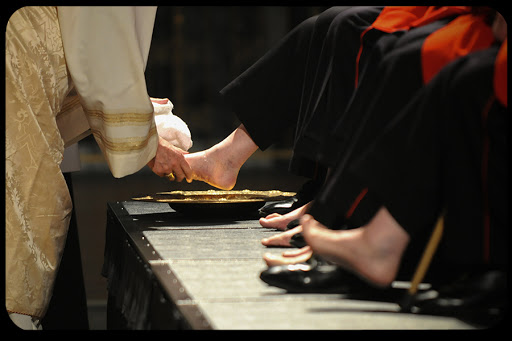The liturgy for Holy Thursday focuses on a meal, the most important meal ever shared, the Last Supper. Many parishes emphasize the Passover aspect of this meal, since in some of the accounts of scripture, Jesus celebrated the Last Supper as part of a Passover meal. In the Gospel of John, the Passover is celebrated after the crucifixion. Perhaps, we shouldn’t get too carried away in the Jewish Seder traditions. St. Gregory of Nazianzus wrote that the Passover meal was a symbol of a symbol. By that he meant that the Passover meal was a symbolic enactment of the first Passover, which took place as the angel of death went through Egypt but passed over the homes of the faithful Hebrews. But the first Passover was itself a prophetic symbol of what would later happen when Jesus celebrated a meal in which He offered Himself as the food, a meal of sacrificial love that freed the people from the death caused by sin.
Take a closer at this meal we call the Last Supper. It began with the foot-washing and the mandatum. The disciples were told from the start that they had to accept Jesus’ humble service. They could not save themselves. Only Jesus could save them. That is why Jesus said over Peter’s objections, “Unless I wash you, you will have nothing of me.” we cannot save ourselves. We have to allow the Lord into our lives, accept His sacrificial love, to receive His salvation. We need to want our Savior.
After He washed their feet Jesus instructed the disciples to follow Him in humble service to their brothers and sisters. “What you have seen me do, you also must do.” That is the mandatum, the mandate of Holy Thursday. To share the Lord’s Body and Blood presupposes that we are willing to share His service to others.
The Synoptic Gospels, Matthew, Mark and Luke, and the First Letter of Paul to the Corinthians all record the central acts of the Last Supper. Jesus said, “This is my Body which will be given up for you,” and “This is the cup of the new covenant in my blood.” The meal is truly a banquet of love, as the disciples and as we receive the sacrificial love of Christ within ourselves. We share in the new covenant, the new relationship with God every time we receive communion.
And we are overwhelmed by this love. We are in Christ and Christ is in us. We are united to Him, and He to us. As a result, we are united to each other, so that reception of the Body and Blood is truly communion–a common union with Christ.
This is all very theological, but every now and then we are given the grace of a real deep experience of what communion truly is. Forgive me for being so personal, but I want to share with you the experience I had a few years ago when I went to the Mayo Clinic in Rochester, MN for a heart procedure. I went up on a Wednesday and had non stop tests and meetings with doctors and medical personal on Thursday and Friday, culminating in a final decision by the doctors as to what they would do the following Monday. It could have all been scary stuff, but really, I felt very peaceful that weekend, because I knew that there were so many people praying for me here, at Guardian Angels, among Life Teen International and others. Also, no matter what happened, everything was in God’s hands, so there was no need to be overly concerned.
Now, adjacent to the Mayo Clinic is the Church of St. John the Evangelist. I went to Mass there Saturday night and Sunday morning. Both times, when I received communion I felt a deep union not just with the Lord, but with the people at that Mass, and with the people here at St. Ignatius. We are all together, paraphrasing Dante in his Paradisio, in the eternal swirl of the Lord’s love. This is what the Eucharist does for us. It unites us to the Lord, and it unites us to each other.
The one liturgy of Holy Thursday, Good Friday and Easter, focuses on the paschal mystery of the Lord’s passion, death and resurrection. We reenact these events in our services, watching with Christ at the Garden of Olives, unveiling a Cross and venerating it as we put ourselves on Calvary, and rejoicing with Mary Magdeline and the disciples as we join them in celebrating the Risen Lord. But our religion is not a spectator sport. Nor do we just recall what took place. We are part of what took place. We are united to the Paschal Mystery through our union in the Body and Blood of Christ. Christ inside of us is still saying at that meal, “Take and Eat.” Christ inside of us is still saying at that meal, “This is the new covenant, the new relationship with God and with each other,” Christ inside of us is still saying from the cross, “I thirst.” Christ inside of us is saying on Easter Sunday, “Receive the New Life, my Life.”
We will never fully understand the Eucharist. After all, it is a mystery. But the more we reflect on this gift, the more we approach a realization of the depth of God’s love for us. Who are we to receive such a gift? We are the people whom God loves.
Fr. Joseph Pelligrino
is a priest of the Diocese of St. Petersburg, Florida and pastor of St. Ignatius of Antioch Catholic Church in Tarpon Springs. This article was originally published on Catholic Journal and is reprinted here with permission.

